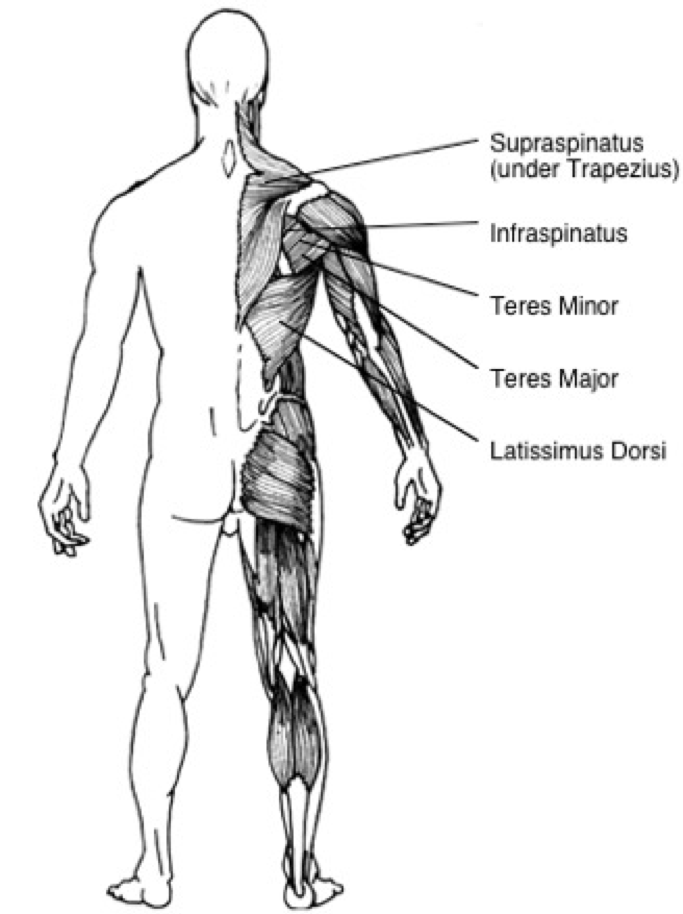By Dr Paul Batman, PhD.https://drummondeducation.com/wp-admin/edit.php
MUSCLE: LATISSIMUS DORSI
DESCRIPTION:
The latissimus dorsi is a broad sheet of muscle commencing from a broad origin across the lower back converging to a small twisting insertion on the humerus.
ORIGIN:
Spinous processes of the lower 6 thoracic vertebrae, lumbar vertebrae, sacral vertebrae, posterior iliac crest, lower 4 ribs and the inferior angle of the scapula.
INSERTION:
Medial lip of the bicipital groove.
MUSCLE GROUPS:
The latissimus dorsi belongs to the following muscle groups:
Shoulder joint extensors, shoulder joint adductors, shoulder joint horizontal abductors (helping), shoulder joint medial rotators (helping).
STRENGTHENING EXERCISES:
Wide grip lat pulldown, one arm dumbbell row, seated row (neutral grip), cable rotate.
CASE STUDY STRENGTHENING EXERCISE: LAT PULLDOWN.
- Position yourself directly underneath the bar of a lat pulldown machine
- Depending on the machine being used you can either sit or kneel under the bar
- Contract your abdominals to protect your lower back
- From this starting position pull the bar down in front of or behind your head to either the top of your shoulders or chest
- Pause in this position and then slowly move the bar back to the starting position
STRETCHING EXERCISES:
Lat and triceps stretch, low back stretch
CASE STUDY STRETCHING EXERCISE: THE LAT AND TRICEPS STRETCH.
- Stand in an upright position with your arms by the side of your body
- Raise your right arm to the side of your body and place it behind your head with your right elbow bent
- Grasp your right elbow with your left hand and gently push it down and towards your head
- Hold the stretch for approximately 20 seconds and then return your right arm to the starting position
- Repeat the stretch on your left arm
PALPATION:
The latissimus dorsi is located on the lower part of the back. Cup the hands around the sides of the lower back and place the heel of your hands on the posterior iliac crest with the fingers pointing diagonally up. It can also be palpated under the arm pit below the teres major.
TRAINERS TIPS:
- The latissimus dorsi is used most powerfully in chinning movements with both a pronated and supinated grip.
- The latissimus dorsi will have a differing role in both a pronated and neutral grip seated row. The neutral grip will recruit the latissimus dorsi as a target muscle, while a pronated grip will use it as a helping muscle. In the pronated grip the emphasis is placed on the recruitment of the infraspinatus and the teres minor as target muscles.
- It has been suggested that latissimus dorsi be trained through the movements of extension and adduction of the shoulder joint. The lat pulldown machine can be used by prescribing wide grip lat pulldowns and narrow grip lat pulldowns to ensure all parts of the muscle are active. This can be done by varying the different bar attachments on the machine.
- The ability to perform the lat pulldown and its variations can be affected by poor strength of the shoulder girdle muscles (trapezius, rhomboids and the pectoralis minor).
- Loss of the latissmus dorsi would drag the shoulder forward due to the pull of the pectoral muscles. Paralysis of the latissimus dorsi and pectoralis major would cause the shoulder to lift up high because of the pull of the serratus anterior, trapezius and rhomboids on the scapula.
- Swimmers often have round shoulders due to the overdevelopment of the latissimus dorsi causing the shoulders to medially rotate.
